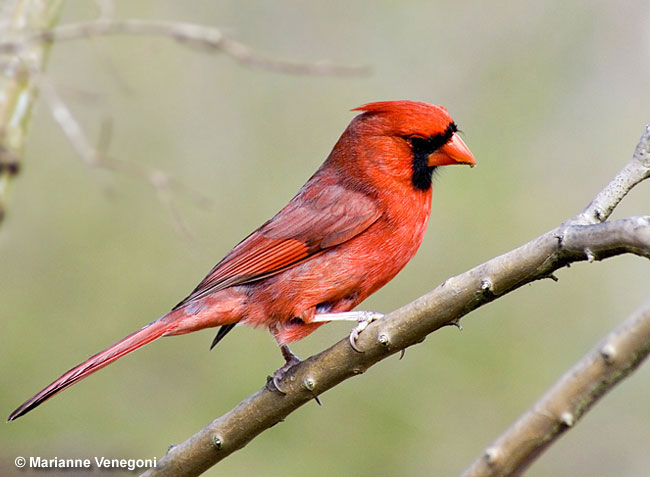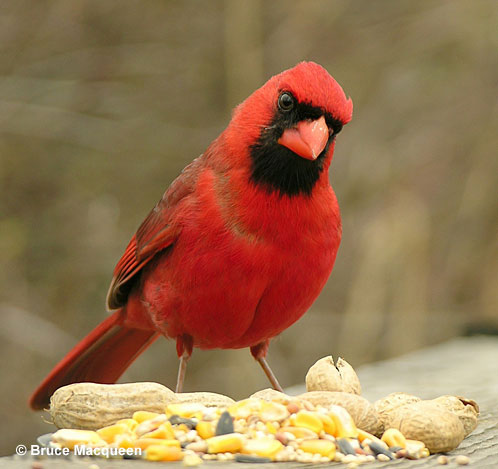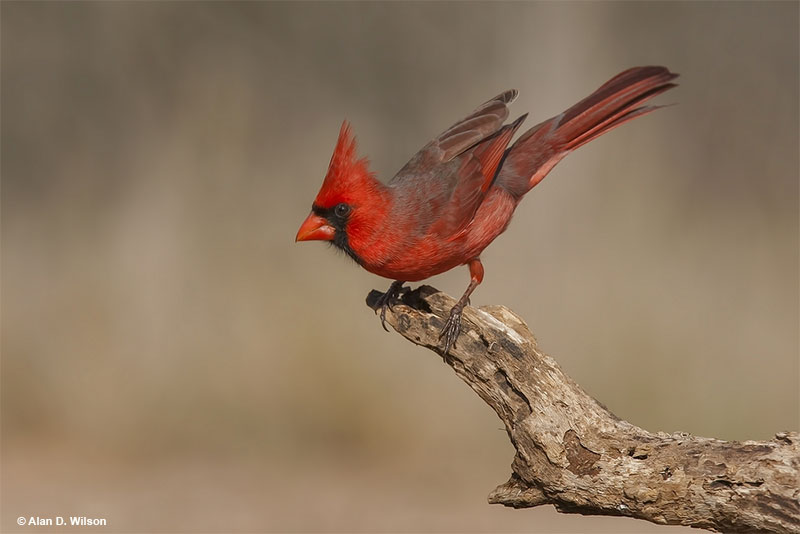
Indiana is a state in the Midwestern United States that places somewhere at the bottom of the list in terms of area and in the middle of the list in terms of population when compared to the other 50 states. Of course, it has its state symbols but we are focusing on the Indiana state bird that is the Northern Cardinal – a medium-sized songbird with vibrant red plumage.
It is the 38th largest state by area, being 36,418 square miles large, and 17th most populated, with almost 7 million inhabitants. Indiana’s central and northern parts are flat, the southern part, however, is a mix of forests and hills. It has cold and dry winters and warm summers with rainfall distributed evenly throughout the year.
It is also known as the redbird, common cardinal, red cardinal, or just cardinal. A more scientific approach would refer to them by scientific name as “Richmondena cardinalis cardinalis.”
On this page
History of Indiana State Bird
People from any state tend to favor the bird that is familiar to them and stays with them throughout the year.
For the people of Indiana (or Hoosiers), it was the Northern Cardinal, and the Indiana General Assembly chose it as the state bird in 1933. Hoosiers also found joy in its red coat and beautiful song.
Northern Cardinals are not only beautiful but also useful. They help humans by eating harmful pest insects and have a significant role in the ecosystem by dispersing seeds.

Facts about The Indiana State Bird
- Northern Cardinal is the state bird of seven U.S. states: Illinois, Indiana, Kentucky, North Carolina, Ohio, Virginia, and West Virginia.
- Northern Cardinals get their vibrant red feathers by eating plants that naturally have yellow, orange, or red pigments. These pigments are called carotenoids and must be ingested because the bird cannot manufacture them itself. If the bird’s diet lacks these pigments, its plumage will dull.
- A genetic plumage variation called xanthochroism can cause the typical red pigment to be absent in their plumage, which is then replaced with vibrant yellow or slightly orange pigments, resulting in a yellow Northern Cardinal. They are incredibly rare!
- Northern Cardinals molt at least once a year, which means that they lose some or all their feathers in the process for a couple of weeks.
- Cardinals are often chosen as the mascot of a sports team. This is due to their fierce and protective nature.
Identification
Northern Cardinal is a medium-sized songbird from the Cardinalidae family that measures 8.2-9.3 inches in length, weighs between 1.2-2.3 oz, and has a wingspan of 9.8-12.2 inches.
The adult male cardinals have vibrant red plumage and a black mask over their eyes and upper chest. The female birds are slightly smaller and very modest compared to their male counterpart, sporting warm grayish-brown and olive colors with reddish highlights.
Both sexes have a distinctive raised crest on top of their heads, thick cone-shaped bright coral-colored bills, dark brown eyes, and a long tail. Young birds resemble the adult female until their first molt in the fall, after which they grow adult feathers. You can distinguish the young from the females by their gray-black bills.

© Elaine R. Wilson
You can meet a Northern Cardinal in most parts of the United States east of the Rocky Mountains and most of Mexico. They are widespread and prefer semi-open or brushy areas that have dense bushes to build their nest in.
Northern Cardinal’s habitats include woodland edges, thickets, suburban gardens, city parks, forest clearings, swamps, and streamside thickets. They can also be seen in the desert in the southwestern United States.
Northern Cardinals build their nest from coarse twigs, cover them with a layer made of leaves, line it with strips of soft bark, and bolster the inside with different fine plant material, including grasses and pine needles. They nest in bramble thickets or low saplings.
Nest
The nests are shaped like a cup and is 2-3 inches tall, 4 inches across, and the inside is 3 inches in diameter.
If you happen upon such a nest that is hidden in dense foliage 1-15 feet above the ground with 2-5 grayish, greenish-white, or pale blue eggs with pale gray to brown blotches on them that are about an inch long and wide, then you might have stumbled upon a Northern Cardinal’s nest.
Call
Northern Cardinals use vocalizations and physical displays to communicate. They learn their songs and as such have different songs and calls from region to region. Their songs typically last for 2-3 seconds and sound similar to high-pitched alarms, consisting of metallic down-slurred or two-parted whistles that usually end in a slow trill.
Common phrases include whoit-whoit-whoit-whoit, what-cheer, cheeeer-a-dote, and purdy-purdy-purdy.
The most common Northern Cardinal’s calls are single or a series of short high-pitched metallic chips. They call like this when trying to chase intruders from their territory, warning others that predators are near, and when approaching the nest with food.
Behavior
Northern Cardinals are not migratory, so they can be seen year-round. They hop on low branches and forage on or near the ground but like to sing and preen on a high branch.
When a Indiana State Bird is agitated, it raises its crest but lowers it back down so it’s barely visible when it’s calm and resting.
During the breeding season from March until September, Northern Cardinals usually fly around in pairs, but they may flock together in fall and winter. They can be seen foraging together with other species, eating mainly seeds, fruit, and insects. While foraging, young birds give way to adults, and females usually give way to males.
Northern Cardinals are serially monogamous and pair up for a year or longer, some mate for life, although up to 20 percent of the pairs split up before the next breeding season. In courtship, the male hops around the female and flutters his wings.
The male proves his worthiness by feeding the female, offering her seeds, worms, berries, and insects. Before building a nest, the female will visit possible nesting sites with the male following along. Usually, the male gathers the material while the female builds the nest.

This species is known for its aggressive and protective habitat. During the breeding season, the male Northern Cardinal will fiercely protect his territory and nest, chasing away intruders, predators, and other males from their species.
They are known to mistakenly attack their reflection on different reflective surfaces such as windows, car mirrors, etc.
More in Indiana: Most common birds | Hawks | Owls | Woodpeckers
You Might Also Ask
What is state bird of Indiana?
The state bird of Indiana is the Northern Cardinal (from 1933)
Why is the Northern Cardinal the state bird of Indiana
The Northern Cardinal is the state bird of Indiana because it is a common and recognizable bird in the state, known for its vibrant red plumage and melodious song.
When did Indiana chose its state bird?
Indiana chose the Northern Cardinal as its state bird in 1933.
What other states have Northern Cardinal as their state bird?
In addition to Indiana, six other states have the Northern Cardinal as their state bird: Illinois, Kentucky, North Carolina, Ohio, Virginia, and West Virginia.
